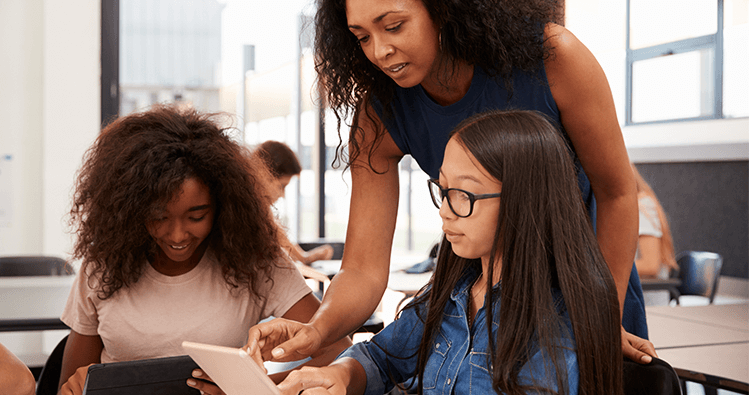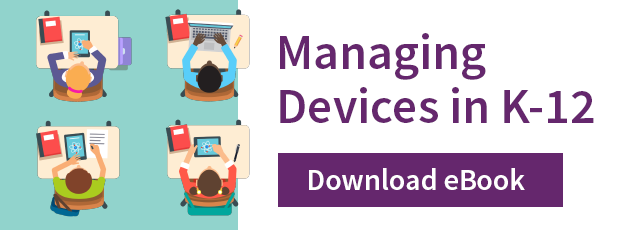How Digital Resources Transform Teaching and Learning
Written by:
Kajeet

Devices in the K-12 classroom are becoming as common as chalk and chalkboards once were, but how do teachers use those devices? Teachers, those on the front lines of this ed tech revolution, see the direct impact of technology on how their students learn.
An Education Week survey of over 700 teachers revealed a majority of teachers feel enthusiastic about the future use of ed tech. But on a daily basis, many said they’re still using digital programs to supplement traditional instruction strategies—drills, reviews, and practice exercises—while using it for interactive projects and collaboration only a few times a week, month, or year.
Despite how frequently teachers use devices, the outlook on digital learning is “overwhelmingly positive” in relation to student achievement (95 percent) and teaching effectiveness (92 percent).
Devices in the digital age transform the way teachers teach and how students learn. Here are just a few examples of their impact.
Textbooks Take on a Whole New Life
Textbooks in the traditional sense – heavy, expensive, hefty hardcovers – are going by the wayside as schools move to digital textbooks and online materials with interactive features.
These digital ‘textbooks’ offer multiple benefits to schools such as cost-effectiveness, always up-to-date content, and instantly available material.
Accessing online content and textbook information is even easier with the rise of OER (Open Educational Resources). Two popular OER platforms include:
- The U.S. Department of Education runs the #GoOpen Initiative to encourage the use of openly licensed educational resources.
- OER Commons is another great resource for educators looking for digital materials with their public digital library.
Integrating Technology in Schools
Edutopia describes successful technology resources in the classroom as, “When technology integration is at its best, a child or a teacher doesn't stop to think that he or she is using a technology tool – it is second nature. And students are often more actively engaged in projects when technology tools are a seamless part of the learning process.”
And that is a great way to think of technology use in the classroom, whether you are integrating a new program or already have devices and resources in the classroom.
Effective technology integration should create a collaborative environment between peers and the technology they use. Technology is more than switching from hard copies to a word document on the computer, but helping students engage and learn in new and exciting ways.
Part of technology that can help students learn differently than previous years is the growth of wearable tech education, such as smartwatches or virtual reality (VR). These wearables can create a more responsive learning environment. For example, students at one elementary school in Indiana are testing wearable technology to help understand the perspective of an insect.
Changing the Literacy Game
Another part of successfully integrating technology into the 21st century classroom is building digital literacy. Cornell University defines digital literacy as “the ability to find, evaluate, utilize, share, and create content using information technologies and the Internet.”
Many resources, such as Common Sense Media, offer information for teachers to build grade-specific lesson plans devoted to:
- Digital literacy.
- Digital citizenship.
- Online ethics.
- “Netiquette.”
- Safety and cyberbullying.
- Making good choices online
Make sure students understand why this technology was brought into the classroom and how it can be used as a tool to help them learn.
Narrowing Down the Ed Tech Options
With so many programs and gadgets now available—and more entering the market all the time—the options may seem limitless, but school budgets are anything but boundless. For this reason, school districts look at where they can get the most return on their investment in terms of learning outcomes.
Read the Kajeet blog post “What Devices are Used in the K-12 Classroom?” to learn more about the difference between tablets and laptops, along with other technology currently used in schools.
The U.S. Department of Education provides budget and funding recommendations for schools and districts as they move toward digital learning:
- Eliminate or reduce existing costs: Moving toward OER or online textbooks can help reduce existing expenses.
- Make full use of federal funds: The E-rate program provides price discounts for infrastructure and technology.
- Rethink existing staff responsibilities: The librarian is an excellent example of a role that has changed with technology.
- Ensure long-term sustainability: Consider technology an ongoing, line-item expense from the very beginning of tech planning.
The latest Kajeet report, “Managing Devices in K-12” goes into more detail on teacher device usage, types of devices, how technology is used outside the classroom and more. If your school or district is implementing or looking to improve your technology program, make sure to download and share this report!


